Seriously, Why Is The Cheesecake Factory's Menu So Long?
Few American chain restaurants are as iconic as The Cheesecake Factory. Though it's at a slightly higher price point than other chain restaurants, that doesn't seem to be driving customers away. The staple makes an incredible amount of money each year; it raked in $3.3 billion last year, and FSR Magazine ranked it 11th for gross among sit-down restaurant chains in the U.S. The chain is also known for two things: its dizzying 30-strong array of cheesecakes (hence the name) and what can feel like the longest restaurant menu in the entire world.
The latter is a point of pride for the company; its website makes a major point to emphasize that it has over 250 menu items — you can't accuse the restaurant of not leaning into its identity. But why in the world is that menu actually so long? The answer is that executives did that intentionally; the absurdly long menu is a deliberate marketing tool.
The Cheesecake Factory wants customers talking about the menu length
Maybe it shouldn't be surprising that The Cheesecake Factory set out to create a ridiculously long menu, but how can something like that be a marketing boon? Simple: no other chain restaurant is doing it.
The Cheesecake Factory doesn't just want people talking about its menu length; it needs it. The menu length is deliberately intended to be a conversation starter. It's not just that customers are supposed to talk about it while they're there; The Cheesecake Factory's goal is to get them talking to potential new customers outside the restaurant, too. It gives them a strong brand identity beyond just cheesecake, bringing in customers (even if only to see how crazy the menu can get). It also keeps marketing costs down; since people are already talking about the company, they only need to spend 0.2% of sales on marketing — a figure that ranks roughly 1,800 times lower than that spent by Darden Restaurants (the parent company of Olive Garden and Red Lobster).
The company also keeps things fresh by updating the menu twice a year. Memorizing that many dishes can't be fun for the company's employees, but as those sales numbers indicate, it certainly works to get people to show up.
Smaller menus are generally better than larger ones
In general, chefs and restaurateurs frequently prefer smaller menus to larger ones for various reasons. Smaller menus tend to keep costs down since they involve fewer ingredients. They save on the kitchen workforce; prep time is reduced significantly when you only have a few things to prep, and it keeps the kitchen running smoothly during service. It's also easier for servers, who can focus on 10 dishes instead of trying to remember the details of 25.
Does this mean that The Cheesecake Factory should shrink its menu? Of course not! In some ways, a larger restaurant chain can benefit a lot more from a larger menu; they generally save on bulk purchases and can standardize for quality in a way smaller chains (or local single spots) can't. And, of course, The Cheesecake Factory's entire identity is built around that menu — and clearly for good reason.


